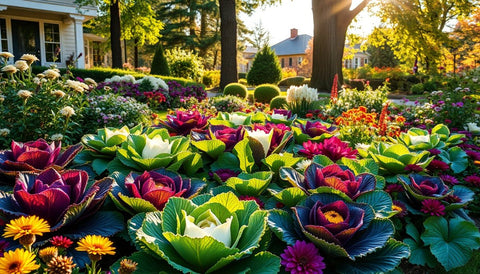Introduction
Imagine walking through your garden during the crisp fall months, vibrant hues of purple, white, and green catching your eye from every corner. The art of fall gardening not only offers a second act to your outdoor spaces but also adds a splash of color even as the foliage starts to fade. One of the most delightful ways to create visual interest during this season? Ornamental cabbage!
These stunning plants, which are closely related to the vegetable cabbage, bring an enchanting palette and unique textures to your garden. Let’s dive into the world of ornamental cabbage and find out how to design a fall garden that will be the envy of the neighborhood.

1. Understanding Ornamental Cabbage
What Makes Ornamental Cabbage Special?
Ornamental cabbage (Brassica oleracea var. acephala) is renowned for its beautiful, rosette-shaped leaves that emerge in a dazzling array of colors—from bold purples and striking whites to delicate pinks and greens. Unlike edible cabbages, these plants are strictly for aesthetic purposes, and they'll bloom beautifully just when you need that extra pop in your fall landscape.
Diverse Varieties to Explore
Just as you’d savor variety in a diverse meal, ornamental cabbage offers a range of options. Flowering kales, with frilled and ruffled leaves, can create a lush look in your garden. You’ll find sizes that range from petite to large, allowing you to use them creatively in different spaces.
Growth Habits You Should Know
These hardy plants thrive in cooler weather, making them perfect for fall. Typically, they grow 12 to 18 inches tall, creating a statement in the garden beds and planters. Understanding their growth patterns will help you enhance your garden design.
2. Planning Your Fall Garden
Choosing the Perfect Spot
When it comes to site selection, consider the amount of sunlight your ornamental cabbage will receive. They prefer full sun to partial shade, about 6 hours of sunlight daily. Also, check the drainage of your soil; these beauties don’t like to sit in waterlogged conditions!
Design Ideas to Spark Your Creativity
- Integrate with Existing Beds: Mix them with your perennials or late-summer annuals to maintain continuity in your garden’s aesthetic.
- Container Magic: Use them as focal points in stunning ceramic pots or trendy metal containers on your porch or patio.
- Pairing with Other Fall Plants: Combine ornamental cabbage with chrysanthemums, pansies, and ornamental grasses for a full fall-inspired display.
3. Planting Ornamental Cabbage
Timing Your Planting Right
Timing can make or break your garden’s success. Ideal planting should happen between late summer and early fall. This will allow your ornamental cabbage to establish itself before the first frost.
Soil Preparation for Success
Here’s a tip—before planting, enrich the soil with compost and organic matter. Aim for a pH level between 6.0 and 6.8 for optimal growth. Healthy soil will provide a solid foundation for your ornamental cabbage to flourish.
Mastering Planting Techniques
Space your ornamental cabbage about 12 to 18 inches apart to promote air circulation. Dig a hole deep enough to accommodate the root ball, and water them immediately after planting. Their thirst in the first few weeks is crucial—don’t let them dry out!

4. Care and Maintenance
Keeping Up with Watering Needs
Ornamental cabbage loves moisture—maintain consistent moisture, especially right after planting. That said, avoid overwatering since soggy soil can lead to root rot.
Fertilization for Vibrancy
Feed your plants with a balanced fertilizer (like 10-10-10) every few weeks to promote healthy colors and growth. A little nourishment goes a long way!
Managing Pests and Disease
While ornamental cabbage is relatively pest-resistant, keep an eye out for aphids or cabbage worms. If pests invade, opt for organic treatments like neem oil.
Pruning and Harvesting Techniques
Consider trimming dead leaves to promote airflow and reduce disease risks. There's no need to harvest ornamental cabbage—their beauty is meant for display!
5. Enhancing Your Fall Garden’s Aesthetic
Finding Fabulous Color Combinations
Think creatively! Ornamental cabbage pairs beautifully with bright yellows of marigolds or deep reds of asters. Create a color scheme that’s both complementary and eye-catching.
Playing with Textures and Shapes
Try using plants with varying heights, forms, and textures to create a layered look. This approach adds depth and intrigue to your garden, making it more engaging.
Adding Seasonal Decor
Get festive! Use pumpkins, gourds, or twinkly lights to accentuate your fall garden. These additions transform your space into a seasonal wonderland.
6. When to Enjoy Your Fall Garden
Peak Viewing Times
The best times to appreciate your fall garden’s beauty often align with cooler evenings or sunny afternoons. Embrace your garden's unique charm during these moments.
Inviting Friends and Family
Don’t keep your beautiful space a secret! Host a garden party or simply invite friends over for a cozy evening under the stars, surrounded by autumn’s splendor.
Documenting Your Progress
Capture your garden’s evolution with photos and share your journey on social media. You’ll inspire others to adopt the beauty of fall gardening too!

Resources and Additional Reading
- Sourcing Seeds/Plants: Check your local nursery or online marketplaces like Burpee or Johnny’s Selected Seeds for high-quality ornamental cabbage.
- Gardening Blogs and Websites: The Old Farmer’s Almanac and Fine Gardening offer great resources for seasonal gardening tips.
- Join Local Gardening Groups: Participate in community gardens or connect with your local botanic society for even more inspiration and guidance.
Happy gardening!





























Comments (0)
There are no comments for this article. Be the first one to leave a message!